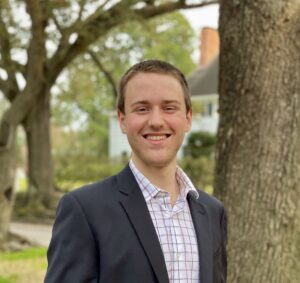By Harvard Law School Student Sam Holloway ’24
The Legal Services Center’s Safety Net Project helps clients with the “social safety net,” but it does a lot more than that, too. Among the Veteran’s Legal Clinic’s three practice areas — the Safety Net Project, the Veterans’ Justice Project, and the trusts and estates practice — I chose the Safety Net Project to learn about trial preparation and case management while I got ready for client hearings. I knew that Safety Net Project students built clients’ trust; constructed factual records; developed a theory of each case; and ultimately argued those theories at administrative

hearings. But I was also pleasantly surprised to discover that the clinic’s work ranged farther, giving me far broader practical lawyering experience than I ever expected.
I worked with one client, for example, whose veterans’ benefit entitlement got miscalculated by the Veterans Administration. The client already received veterans’ benefits payments, but because of an accounting error at the VA, those payments were significantly lower than they should have been. I had to figure out what to do; there was no guide, no formal appeals process to fix such an error. It is there that the clinic first instilled an important lesson: a lawyer’s job is to “figure it out.” I studied the relevant benefit programs until I understood how they should work; figured out what, specifically, went wrong; and (along with my clinical instructor) liaised with VA personnel and coached my client through the necessary administrative fixes. The VA corrected his benefits, and I learned that my own training and experience could fit new problems better than I anticipated.
Another client needed a passport, but during the application process, got stymied by a spelling error on his birth certificate. His name – the name everyone calls him, the one on his driver’s license and marriage certificate – starts with a “P.” His birth certificate, however, inexplicably lists him as “H____” instead of “P____.” After the client tried hard to correct things himself, he hit a bureaucratic dead end. We worked together to gather necessary documentation, I figured out the proper contact people, and I followed up repeatedly until my client finally received his corrected birth certificate. That was not in my “formal” clinic job description either, but it was certainly in the clinic’s range – and within my own power – to do something.
The Legal Services Center also helps seal criminal records, but in another post, I discuss how that still might not be the end of the story sometimes. There, my client sealed his criminal charges with the government, only to discover that two news articles still reported about those charges — even though my client never got convicted. By contacting the publishers and humanizing my client, I helped convince them to de-list the articles, clearing my client’s name without any “legal” action at all.
At the semester’s end, my clinic experience thereby became an invaluable exercise in “Swiss army knife” lawyering and client service. Every case I touched had elements beyond my comfort zone, but that was the Safety Net Project’s biggest blessing. My whole job as a lawyer will be harnessing uncertainty to my own client’s advantage, and here, I got fantastic practice.
*Client’s name has been changed for confidentiality.
